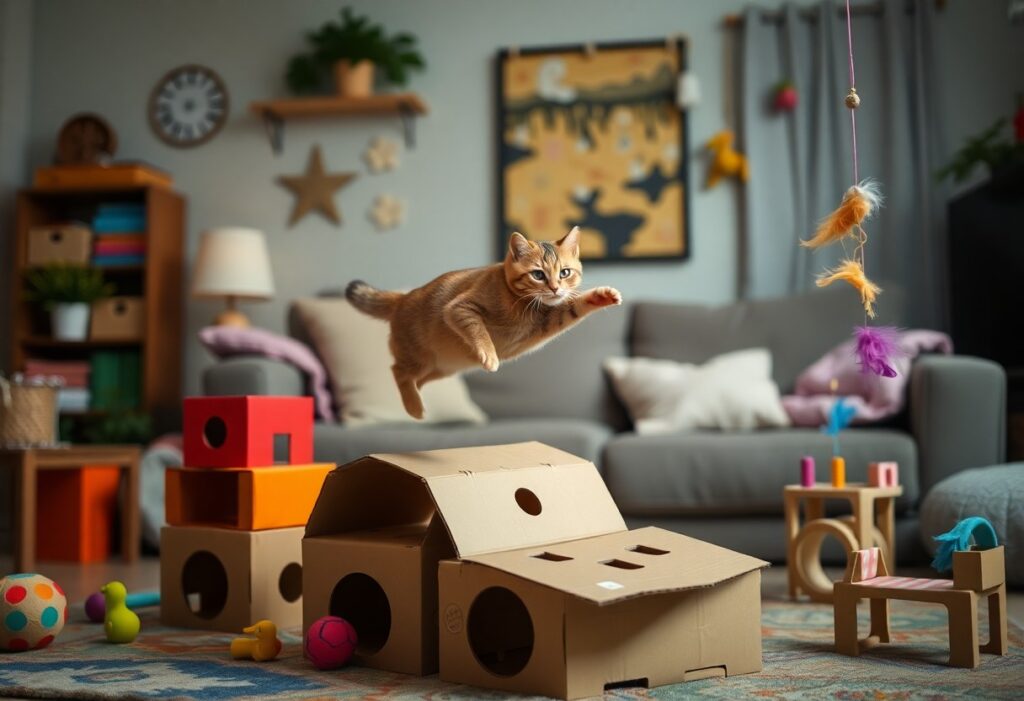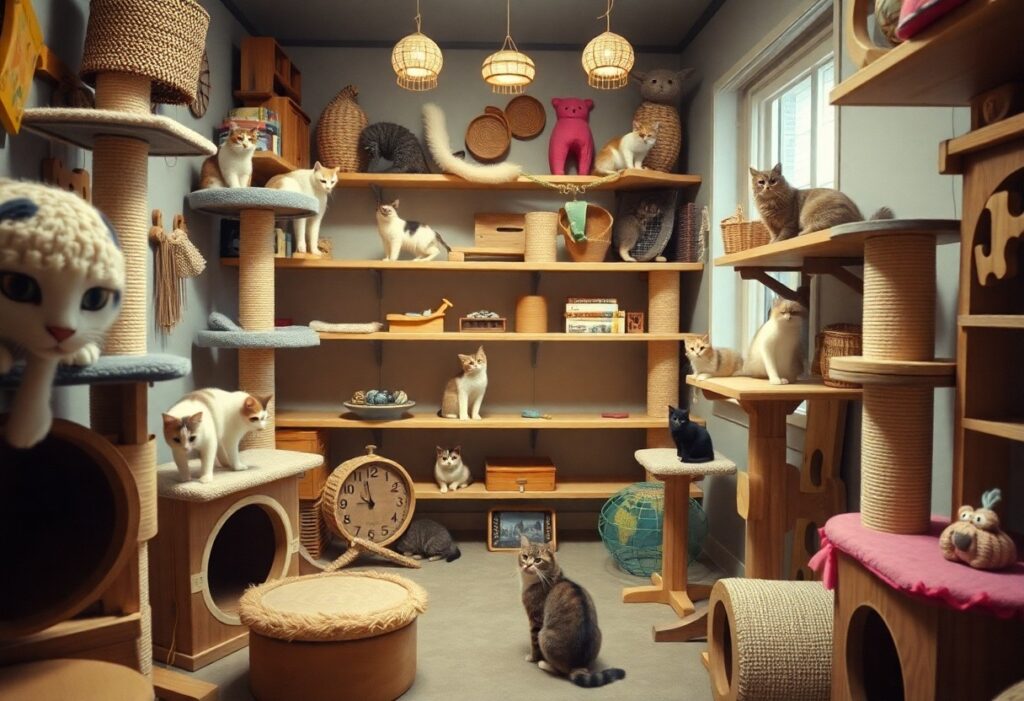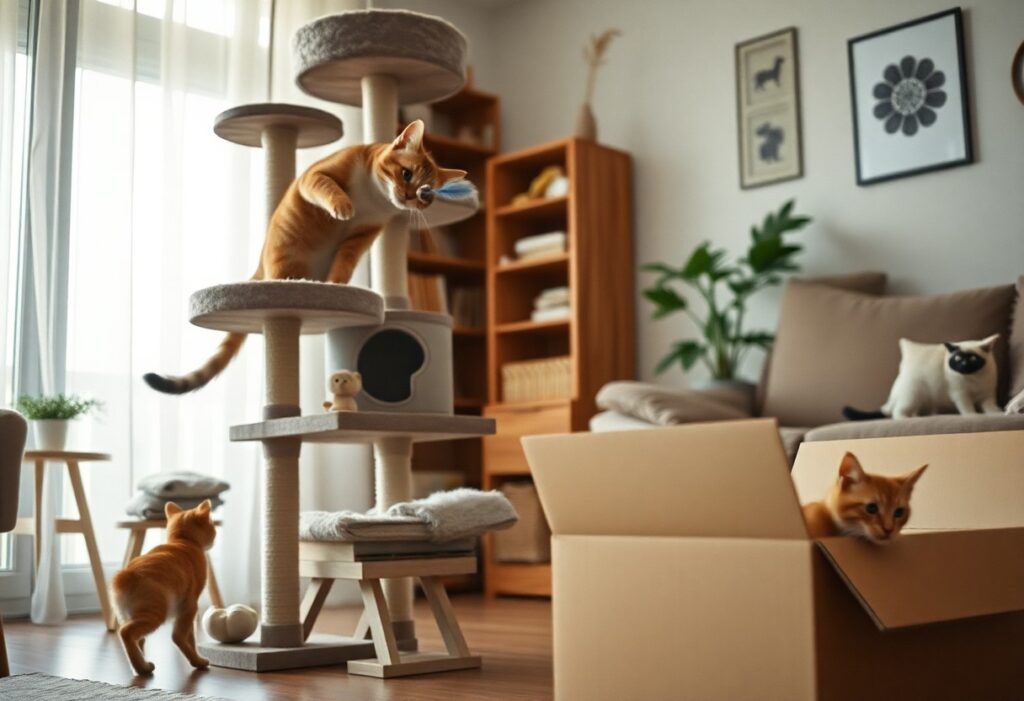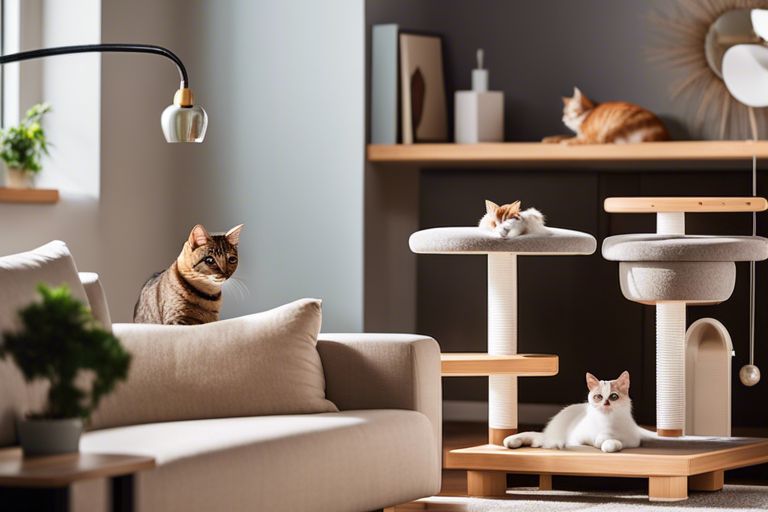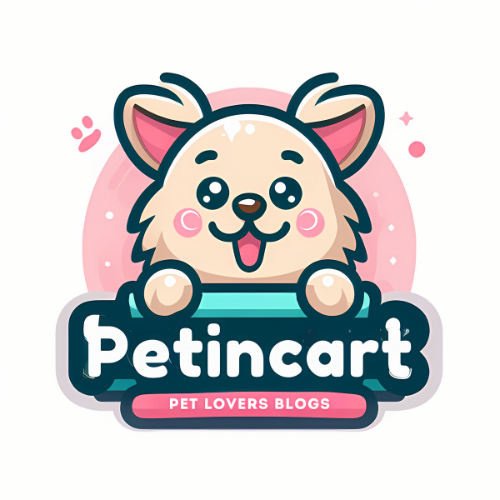Just imagine your feline friend pouncing and playing in excitement! In this guide, you’ll learn how to create engaging indoor games that cater to your cat’s adventurous spirit. By utilizing simple materials and a bit of creativity, you can provide your pet with mental stimulation and physical exercise, ensuring they stay happy and healthy. Follow along as we explore fun ideas that will keep your kitty entertained for hours, all while fostering a deeper bond between you and your playful companion.
Key Takeaways:
- Incorporate a variety of textures and materials in your games to stimulate your cat’s senses and promote engagement.
- Utilize everyday household items, such as boxes and tunnels, to create safe and interactive play spaces that encourage exploration.
- Design games that involve movement and problem-solving, like treat puzzles or feather chases, to keep your cat physically and mentally active.
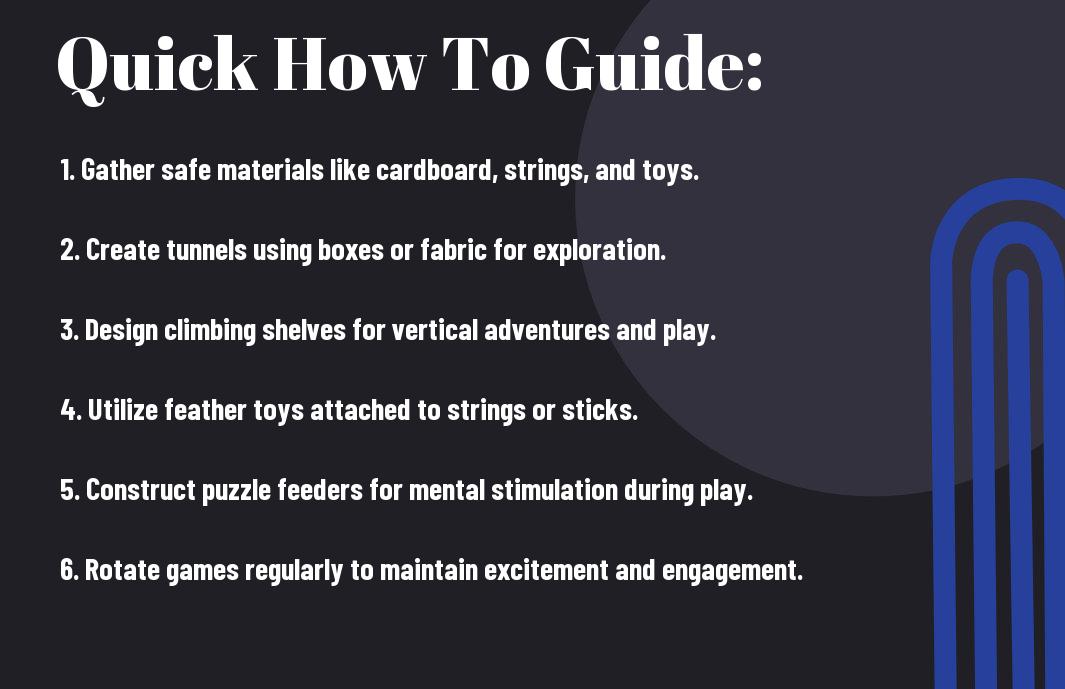
Understanding Your Cat’s Play Behavior
For most cats, play is an important part of their daily routine, imitating hunting behavior and stimulating their minds. Your cat’s playful instincts vary widely and understanding these behaviors can help you tailor engaging indoor games that appeal to their unique personalities. Each cat possesses distinct play preferences based on several variables, including age, breed, and individual temperament.
Factors That Influence Play Preferences
Play behaviors can be impacted by various factors that shape your cat’s preferences. Consider the following:
- Age: Kittens are often more energetic while older cats may prefer gentler activities.
- Environment: A stimulating environment with several enrichment opportunities can energize play.
- Energy Level: Some cats are natural athletes and love high-energy games.
- Socialization: Well-socialized cats often enjoy interactive play with humans or other pets.
Recognizing these factors can significantly enhance your cat’s play experience.
Tips for Observing Your Cat’s Interactions
The ability to observe your cat’s interactions is key to developing games that capture their interest. Pay attention to how your cat engages with various toys and environments. Look for:
- Body language: Understanding signals such as tail movement, ears position, and overall posture.
- Vocalizations: Sounds can indicate whether your cat is enjoying the game or feels overwhelmed.
- Focus: Notice what captures their attention; this can guide you in choosing the right toys.
- Energy shifts: Monitor their energy levels as it may indicate when they’re ready to play or rest.
Perceiving these interactions is fundamental to meeting your cat’s play needs effectively.
Cats exhibit a range of behaviors during play that can offer insights into their preferences and moods. Watching how they react to different types of toys, from balls to feather wands, provides valuable clues. Engage with them using various play techniques and establish a safe space to observe their true nature. Observe:
- Engagement Level: Are they enthusiastic or indifferent to certain toys?
- Play Style: Do they prefer pouncing, chasing, or stalking?
- Reaction to New Toys: How does your cat respond to novel objects?
- Frustration Signs: Are they easily irritated, indicating the need for simpler play?
Perceiving these details closely will enable you to design indoor games that cater to your adventurous feline friend effectively.
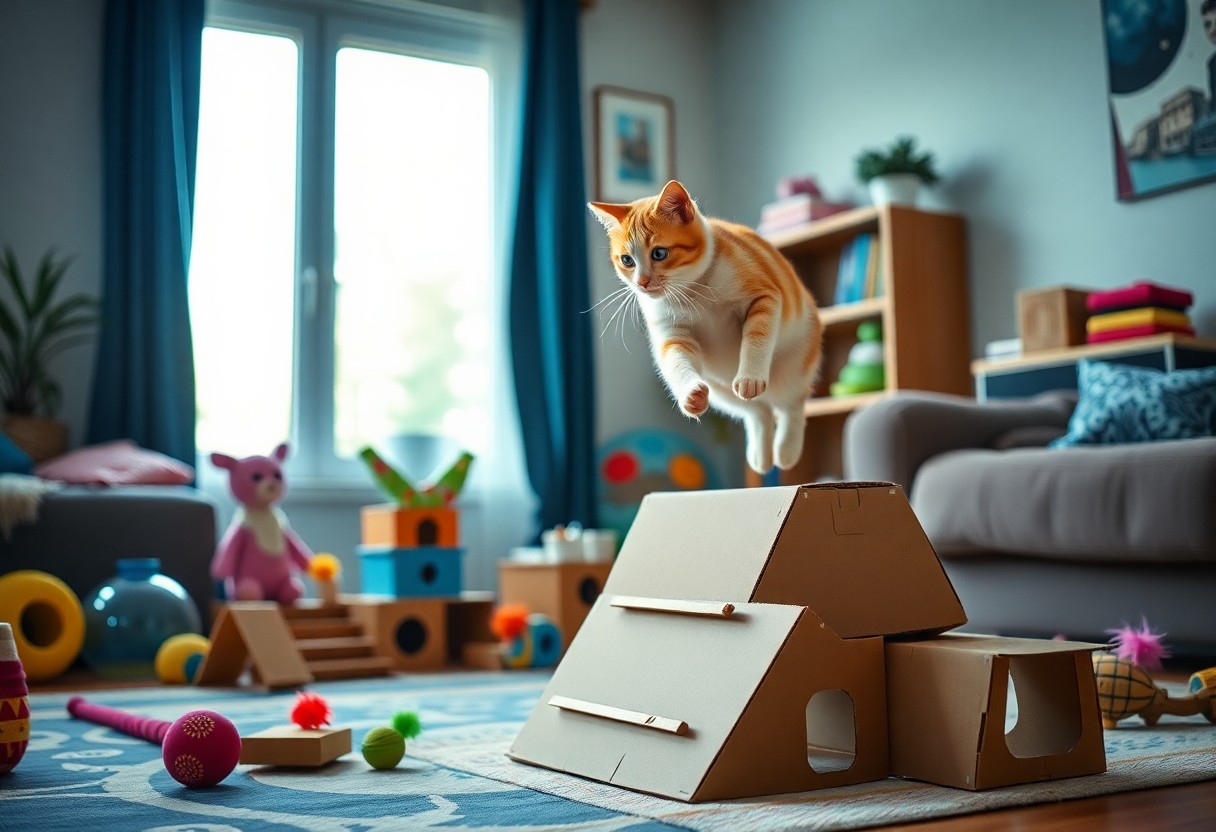
Selecting the Right Materials
Clearly, choosing the right materials is crucial for crafting engaging indoor games that keep your adventurous cat entertained. Look for supplies that are both safe and stimulating, as they will ensure your feline friend has a rewarding experience. Consider the textures, colors, and sizes of items, which can affect your cat’s interest and interaction with the games you create.
How-to Choose Safe and Engaging Supplies
An effective game for your cat begins with selecting the right supplies that are both engaging and safe. Opt for materials that are non-toxic and free from small parts that could pose a choking hazard. Catnip-filled toys, cardboard boxes, and soft fabric are great choices, as they encourage interaction and playfulness while ensuring your cat remains safe during playtime.
Tips for Upcycling Household Items
An excellent way to craft indoor games is by upcycling household items that you no longer need. Here are some ideas for transforming everyday objects:
- Use cardboard boxes to create obstacle courses or hiding spots.
- Repurpose old socks into fun pom-poms filled with catnip.
- Turn paper towel tubes into engaging puzzle toys by hiding treats inside.
- Craft string toys from discarded fabric scraps for playful batting.
Perceiving the potential in what you already own not only helps the environment but also offers your adventurous cat new and exciting ways to play!
Selecting the right upcycled items involves evaluating them for safety and ensuring they possess engaging qualities for your cat. Avoid items that contain sharp edges or harmful chemicals. Cardboard is usually a great choice since it’s soft and can be altered easily. Additionally, consider using bottle caps or plastic containers that can be securely closed, providing enrichment without hazards. Perceiving the charm in these items can unlock a treasure trove of imaginative play for your feline companion.

Designing Your Indoor Game
After gathering inspiration, it’s time to focus on designing your indoor game. Think about your cat’s preferences, energy levels, and individual quirks to create a personalized experience. You can mix various elements such as tunnels, climbing platforms, and hiding spots to promote exploration and engagement. By considering your cat’s natural hunting instincts, you can tailor the game to satisfy their need for stimulation, ensuring they have an adventurous time indoors.
How-to Create Interactive Obstacles
Howto add excitement to your indoor game by creating interactive obstacles that challenge your cat’s agility and curiosity. You can use everyday household items like furniture or boxes to construct interesting pathways. Incorporating varying heights and textures will encourage your cat to leap, climb, and explore. You might also include hidden treats in small containers to motivate them further, stimulating their natural instincts while providing accountability for their playtime.
Tips for Incorporating Variety into Play
You can create a more dynamic play experience by incorporating variety into your indoor games. Try these tips to keep your sessions fresh and engaging:
- Rotate different types of toys to maintain interest in play
- Vary the locations of obstacles to create new exploration paths
- Incorporate different challenges, such as speed or agility exercises
- Track your cat’s preferences to optimize future game designs
After mastering these tips, your cat will always have something new and exciting to engage with during playtime.
into the design of your games, it’s vital to continually adapt your approach. Keeping playtime dynamic and unpredictable will help maintain your cat’s interest over time. Vary the types of challenges and obstacles to strengthen their skills and encourage their natural instincts. Try these strategies to keep things exciting:
- Introduce puzzles or toys that require problem-solving skills to keep them engaged
- Schedule regular play sessions, altering the theme, such as a miniature hunt or obstacle course
- Watch for your cat’s mood and tailor sessions based on their energy levels to keep things adaptable
- Provide different textures and scents to pique their curiosity during play
After exploring these techniques, you’ll create a stimulating environment that keeps your adventurous cat entertained for hours.
Introducing Your Cat to New Games
Now that you’ve crafted some exciting indoor games, it’s time to introduce them to your adventurous feline. Start by observing your cat’s reactions and moods. Gradual introduction is key; allow your kitty to explore the new toys at their own pace. This fosters a comfortable environment where your cat feels safe and engages willingly with the activities you’ve created.
How-to Gradually Introduce Games
Introduce new games slowly, ensuring your cat isn’t overwhelmed. Start with one game and let your kitty investigate it at their leisure. Use familiar scents from their existing toys to help them make connections. Gradually increase the complexity of the games, keeping sessions short and enjoyable to maintain your cat’s interest.
Tips for Encouraging Engagement
With a little creativity, you can encourage your cat to engage with the new games. Here are some effective tips:
- Use texture variations to spark interest.
- Incorporate sound elements like bells or crinkly materials.
- Make the games interactive by using treats as incentives.
Perceiving your cat’s reactions will guide you in adjusting the games to better fit their preferences.
As you enhance your games, consider your cat’s unique personality and play style. A few additional tips for fostering engagement include:
- Engage in playtime to strengthen your bond.
- Change the toys regularly to maintain novelty.
- Add challenges, like hiding toys for your cat to discover.
Perceiving what excites your cat will help create an enjoyable atmosphere for play.
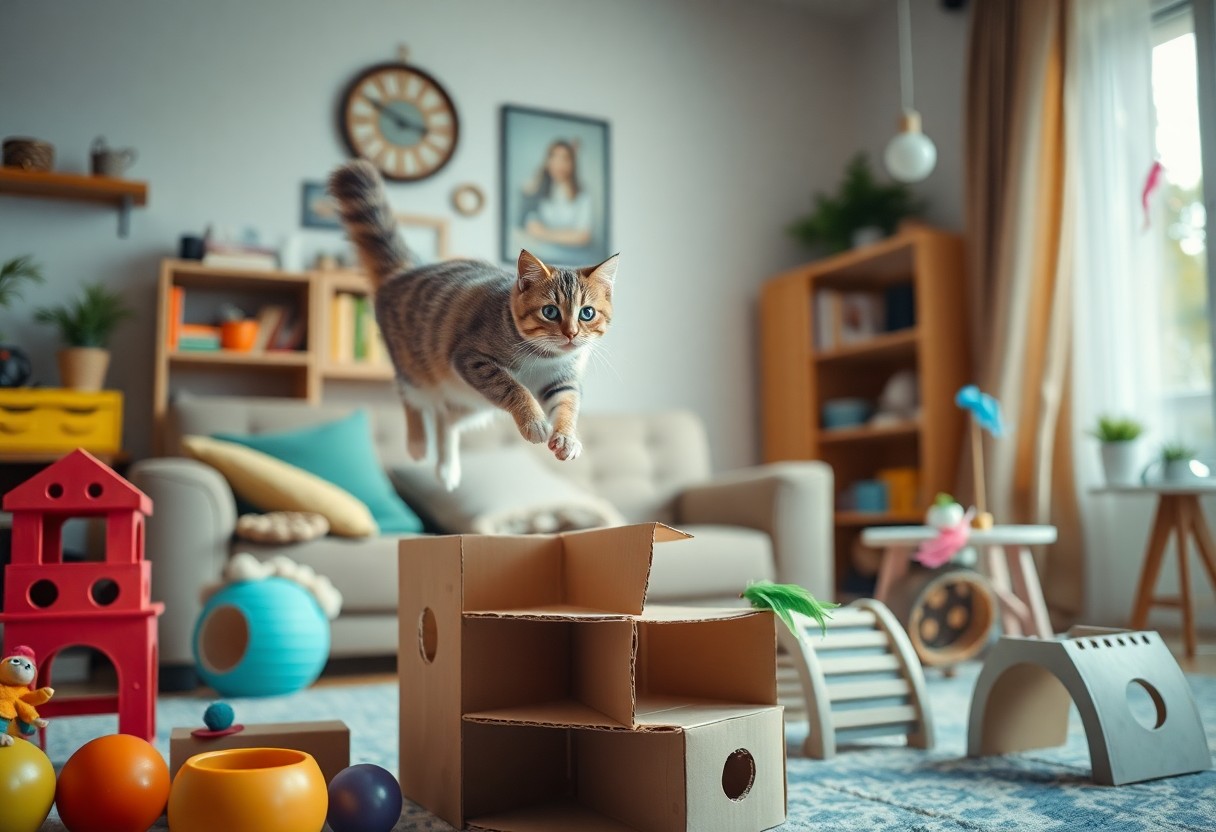
Monitoring and Adjusting Gameplay
To keep your adventurous cat engaged, it’s important to continually assess and modify their play experiences. Regularly observing your cat’s behavior during your crafted games can provide insight into what captivates them and what may require adjustments. Ensure you create a playful environment that evolves with your cat’s interests and energy levels.
Factors to Consider for Ongoing Engagement
With a few key aspects in mind, you can enhance your cat’s playtime experience:
- Variety: Introduce new games regularly.
- Difficulty: Adjust the challenge according to your cat’s skill level.
- Interaction: Engage with your cat during playtime.
- Environment: Change the play space to keep it fresh.
After considering these factors, you’ll ensure sustained excitement for your feline friend.
How-to Recognize Signs of Boredom
Any shifts in your cat’s behavior can indicate boredom. Look for symptoms like disinterest in play, excessive sleeping, or seeking out solitary spaces. Cats are naturally curious creatures and when they become disenchanted, they might also engage in destructive behaviors to express their frustration or restlessness.
Another important sign is a lack of interaction with toys or activities that once brought them joy. If you notice your cat pawing at toys without enthusiasm or choosing to ignore them, these are clear indicators that you should reassess their gameplay options. To prevent your cat from becoming truly bored or stressed, consider introducing interactive puzzles or refreshing their play environment, as this can lead to a more stimulating and positive experience.
Additional Game Ideas for Adventurous Cats
Once again, your creativity can take center stage with unique games designed to stimulate your adventurous cat. Consider using cardboard boxes to create a maze or setting up a scavenger hunt with their favorite toys. Incorporate puzzle feeders for an added challenge, or use a fishing rod toy to simulate the thrill of the hunt. Tailoring these ideas to match your cat’s interests will guarantee they remain engaged and entertained, providing both mental and physical exercise.
How-to Create Theme-based Challenges
Theme-based games can add an exciting twist to your cat’s playtime. You can design challenges based on seasons, holidays, or even popular movies. For instance, a Halloween-themed adventure may include creepy decorations and spooky sound effects, whereas a summertime game might involve beach toys and a sandbox for digging. Themed experiences not only keep your cat’s instincts sharp but also make playtime delightful and memorable.
Tips for Seasonal Game Variations
For seasonal adaptations, consider how weather and festivities can inspire your game creation. Add seasonal flair to your indoor challenges with variations such as:
- Spring – Use colorful fabric flowers or faux butterflies to entice your cat.
- Summer – Introduce cooling mats or water games for hot days.
- Fall – Hide treats in autumn-themed decorations like mini pumpkins.
- Winter – Create a snowy landscape with white blankets for hiding and seeking.
The key to maintaining their interest is to continuously adapt and innovate your game concepts to match the changing seasons.
Tips for enhancing your seasonal games can profoundly impact your cat’s overall experience. Take note of their preferences while implementing these ideas:
- Observe your cat’s play style to tailor challenges.
- Rotate different toys to keep the allure alive.
- Safe items are fundamental; avoid small pieces that could be swallowed.
- Involve treats as incentives to spark excitement.
The right seasonal adaptations will ensure your feline stays entertained while providing a chance for both of you to bond over playful activities.
To wrap up
Hence, by utilizing simple materials and engaging your creativity, you can craft whimsical indoor games that keep your adventurous cat entertained and mentally stimulated. Incorporate varied textures and movement to pique their interest, and don’t hesitate to customize each game to suit your cat’s unique personality. By dedicating time to create these enriching experiences, you’re not only enhancing your cat’s quality of life but also strengthening the bond you share. Enjoy the playtime, and watch your feline friend thrive in their playful adventures.
FAQ
Q: What materials do I need to create indoor games for my cat?
A: To craft whimsical indoor games for adventurous cats, you’ll typically need common household items and a few pet-safe materials. Gather cardboard boxes, string, feathers, paper balls, tunnels, and low-cost fabric. Items like plastic cups or balls, paper towel rolls, and even old toys can be repurposed for games. Always ensure that the materials are safe for your cat, avoiding anything that may pose a choking hazard or contain toxic components.
Q: What are some easy indoor game ideas for my cat?
A: There are plenty of simple game ideas you can try. One popular idea is creating a cardboard box maze where your cat can explore and hide. You can also craft a fishing pole toy by attaching a feather or a string to a stick. Additionally, consider making laser pointer challenges using a laser pointer to lead your cat on a fun chase. Hide treats in various puzzle toys or empty containers for a scavenger hunt effect that encourages their natural hunting instincts.
Q: How can I make games challenging yet safe for my cat?
A: To strike a balance between challenge and safety, observe your cat’s behavior and abilities closely. Start with simpler games that require minimal effort and gradually increase the difficulty. Ensure that the toys cannot break into small pieces or pose choking hazards. Avoid using small bells or other components that can be swallowed. Be attentive to your cat’s reaction during playtime, and if they seem frustrated or overwhelmed, simplify the game. Always supervise playtime to ensure your cat remains safe while enjoying their games.
Q: Can making games for my cat strengthen our bond?
A: Yes, crafting and playing interactive games with your cat can significantly strengthen your bond. Engaging in playtime not only provides mental and physical stimulation for your cat but also creates shared experiences that foster trust and affection. As you both enjoy these playful moments together, you’ll establish a connection based on fun and collaboration. Keep sessions positive, and use your voice and body language to communicate enthusiasm and encouragement, which will help your cat associate you with enjoyable activities.
Q: How often should I change the games I create for my cat?
A: Regularly changing the games you create for your cat is important to maintain their interest and stimulate their curiosity. Introducing new designs or variations about once every few weeks can keep things exciting. You may choose to rotate between a few favorite activities to prevent your cat from becoming bored. Furthermore, assess what games your cat enjoys most and adapt them to sustain their engagement. Keeping playtime varied and lively will enrich your cat’s indoor experience and encourage ongoing mental and physical activity.
